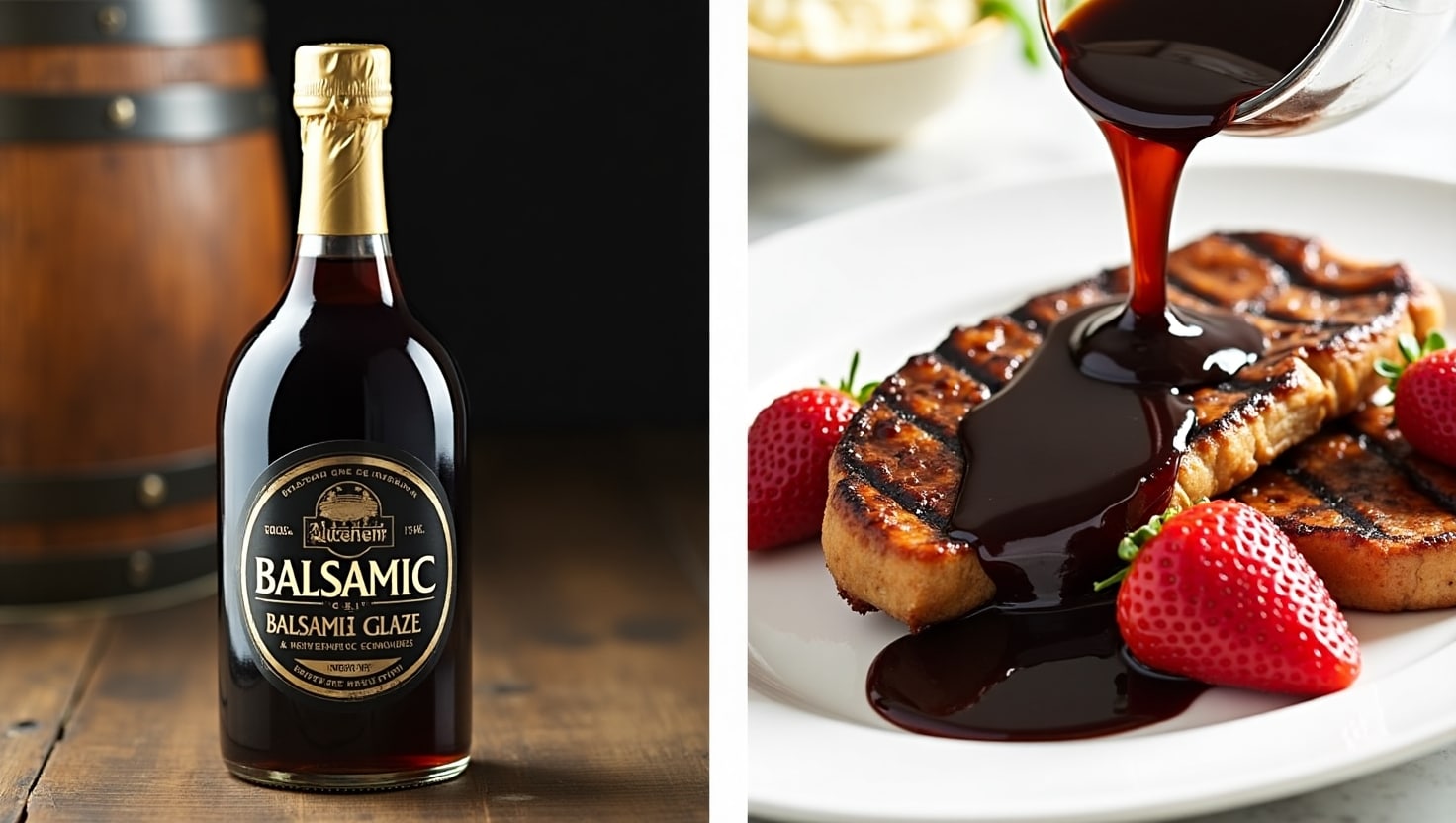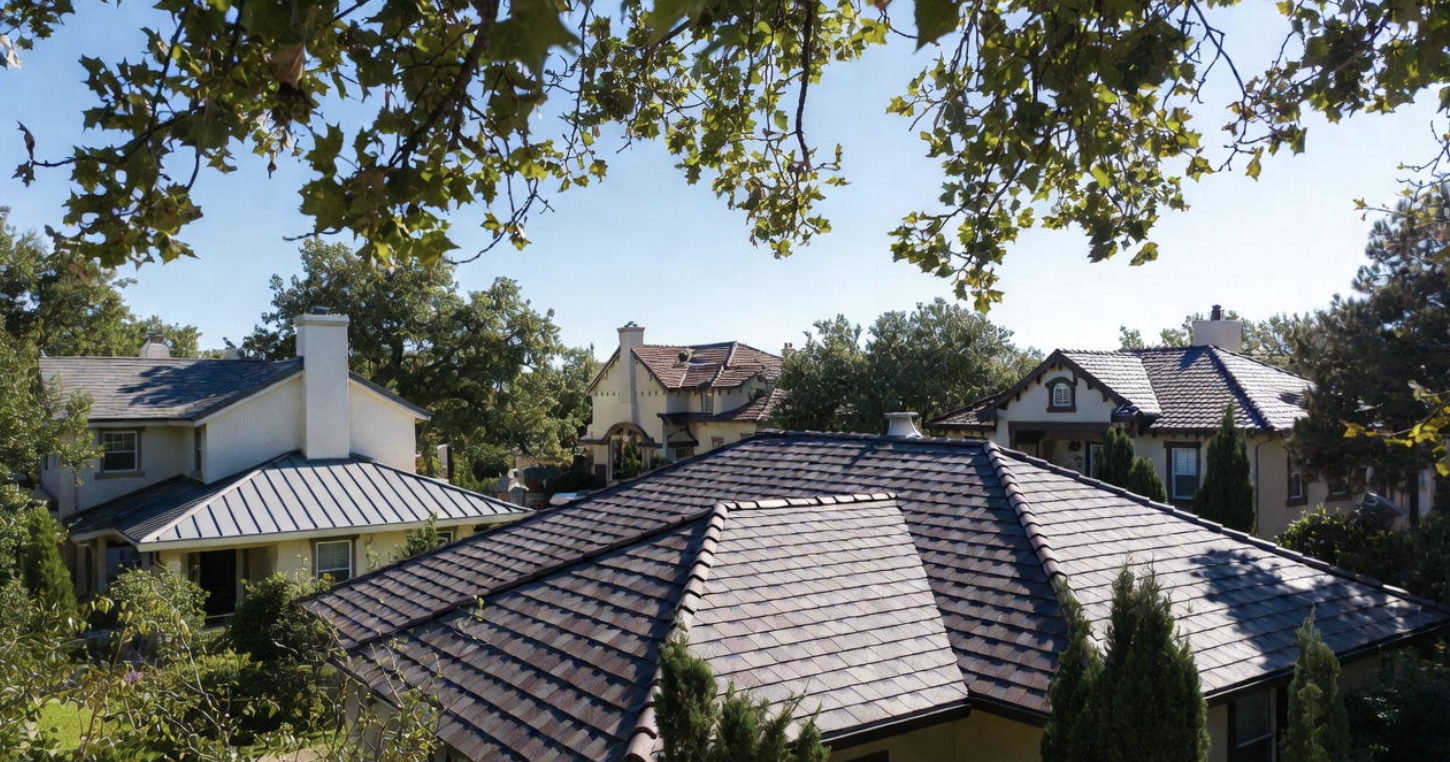Standing in the condiment aisle, looking at balsamic vinegar and glaze can make anyone wonder which to choose. Although they look alike, they serve different purposes in cooking!
You might grab one, thinking it works for your recipe, only to find it completely changes the taste.
I know this confusion well and can help you make the right choice for your dishes.
In this article, I’ll explain what makes these two condiments distinct, when to use each one, and how they affect the flavor of your food.
You’ll learn their key differences in taste, texture, and cooking uses, so you won’t ever grab the wrong bottle again.
What Is Balsamic Vinegar?
- Definition and origins of balsamic vinegar: Balsamic vinegar is made from grape must—freshly crushed grape juice with skins, seeds, and stems and is mainly produced in Italy’s Modena and Reggio Emilia regions.
- The production process: traditional vs. modern methods: Traditional balsamic ages in wooden barrels for 12-25 years, getting thicker and more complex. Modern versions use shortcuts with wine vinegar, caramel, and thickeners, taking just hours or days to make.
- Key characteristics (flavor profile, acidity, uses): It has a deep brown color with a perfect mix of sweet and sour notes. Good balsamic offers hints of cherry, fig, and molasses with a mild acidity that works in many dishes.
- Health benefits and culinary applications: It contains antioxidants that help digestion and blood sugar control. In cooking, it shines in salad dressings and marinades and can even add depth to fruits and desserts.
What Is Balsamic Glaze?
- Definition and origin of balsamic glaze: Balsamic glaze is a thick, syrupy reduction made from balsamic vinegar. It began in Italian kitchens as a way to create a more intense version of the vinegar for special dishes.
- How balsamic glaze is made: from balsamic vinegar to glaze: To make the glaze, balsamic vinegar is simmered over low heat until it reduces to about half its volume. Sometimes, sugar is added to boost sweetness. The result is a thick sauce that coats the back of a spoon.
- Differences in texture and sweetness: The glaze feels much thicker than vinegar, similar to honey or maple syrup. It’s also much sweeter with less tang, making it more like a dessert topping than a sharp vinegar.
- Common culinary uses and presentation: It works wonderfully drizzled over cheese plates, strawberries, ice cream, and grilled meats. The glaze adds visual appeal with its shiny finish and ability to make artistic patterns on plates.
A Closer Look at the Flavors of Balsamic Vinegar and Glaze
- Tasting notes of balsamic vinegar: tanginess and acidity
Balsamic vinegar offers a complex flavor with bright acidity. It has a sharp tanginess that hits first, followed by mild sweetness. The taste includes woody notes with hints of cherry and fig. Its thin consistency flows freely over food. - Tasting notes of balsamic glaze: sweetness and syrupy texture
Balsamic glaze leads with intense sweetness rather than acidity. The sugars concentrate during reduction, creating a rich, caramel-like flavor. Its thick, syrupy texture clings to food and feels velvety on the tongue. - How each complements different types of dishes
Vinegar cuts through fatty foods and adds bright notes to salads and raw vegetables. Glaze works better as a finishing touch on grilled meats, aged cheeses, and desserts where its sweetness and texture can shine.
Comparison Table: Balsamic Vinegar vs Glaze
| Feature | Balsamic Vinegar | Balsamic Glaze |
|---|---|---|
| Primary Taste | Tangy, acidic | Sweet, caramelized |
| Texture | Thin, free-flowing | Thick, syrupy |
| Aroma | Complex, woody | Sweet, concentrated |
| Best Used | In dressings, marinades | As finishing drizzle, desserts |
| Impact on Dish | Adds brightness, cuts fat | Adds richness, visual appeal |
When to Use Balsamic Vinegar vs. Balsamic Glaze?
1. Best Uses for Balsamic Vinegar (Salads, Dressings, Marinades)
Balsamic vinegar shines in homemade salad dressings when mixed with olive oil, herbs, and a touch of mustard. It adds depth to marinades for chicken, pork, and beef without making them too sweet. For roasted vegetables, a splash before serving brings brightness. It’s also perfect for deglazing pans after cooking meat to make quick, flavorful sauces.
2. Best Uses for Balsamic Glaze (Drizzling, Appetizers, Desserts)
Due to its thick consistency and sweetness, balsamic glaze works best as a finishing touch. Drizzle it over bruschetta or Caprese salad for visual appeal and a flavor boost. It pairs beautifully with cheese plates, particularly with aged hard cheeses and fresh goat cheese. For desserts, a drizzle over vanilla ice cream, fresh strawberries, or panna cotta creates an elegant finish.
3. Pairing Each with Different Ingredients and Cooking Styles
Pair vinegar with foods that need acid balance, such as fatty meats, beans, and hearty greens. It works in slow cooking methods, where its flavor can mellow and blend. Glaze matches well with already-cooked foods and quick-cooking methods, where its sweetness won’t burn. It complements rich foods like duck, risotto, and aged cheeses, where its concentrated flavor creates contrast.
Nutritional Differences Between Balsamic Vinegar and Glaze
1. Nutritional Breakdown of Balsamic Vinegar
Traditional balsamic vinegar is low in calories, with about 14 calories per tablespoon. It contains no fat and minimal sodium. The aging process creates compounds that may help lower cholesterol and improve digestion.
Balsamic vinegar contains small amounts of potassium, calcium, and iron. Its antioxidants can help fight cell damage and boost the immune system.
2. Nutritional breakdown of Balsamic Glaze
Balsamic glaze is more calorie-dense, with 40-45 calories per tablespoon due to concentration and often added sugars. The reduction process concentrates both beneficial compounds and sugars.
Store-bought glazes may contain additional ingredients like cornstarch, caramel color, or sweeteners that affect nutritional value. The thicker consistency means people often use less per serving.
3. Balsamic Glaze Sugar vs. Vinegar’s Health Advantages
The added sugars in the glaze can counter some health benefits, especially for those watching blood sugar levels. While both contain antioxidants, vinegar offers these benefits without the extra sugar load.
Plain vinegar is the better choice for heart health and weight management. However, using small amounts of glaze as a finishing touch can still be part of a balanced diet.
Nutritional Comparison Table
| Nutritional Factor | Balsamic Vinegar (1 Tbsp) | Balsamic Glaze (1 Tbsp) |
|---|---|---|
| Calories | 10-15 calories | 40-45 calories |
| Sugar | 2-3g (natural) | 8-10g (often with added sugars) |
| Fat | 0g | 0g |
| Sodium | 5-10mg | 10-20mg |
| Antioxidants | High | High but with sugar offset |
| Best for Health | Blood sugar control, heart health | Used sparingly as a treat |
| Serving Size Typically Used | 1-2 tablespoons | 1-2 teaspoons |
Conclusion
Choosing between balsamic vinegar and glaze depends on the recipe. Both have their place in the kitchen.
Vinegar brings bright acidity to dishes, making it perfect for dressings and cooking. Glaze offers sweet richness as a finishing touch on completed dishes.
For health-minded cooks, vinegar is the best choice because it contains fewer calories and sugars while still offering flavor complexity. Glaze is best used sparingly when you want visual impact and sweetness.
Keep both in your pantry for different purposes: vinegar for everyday cooking and glaze for those times when you want to add a special finishing touch. The right choice depends on your dish, cooking method, and desired flavor balance.
Now, you can confidently grab the correct bottle every time!










